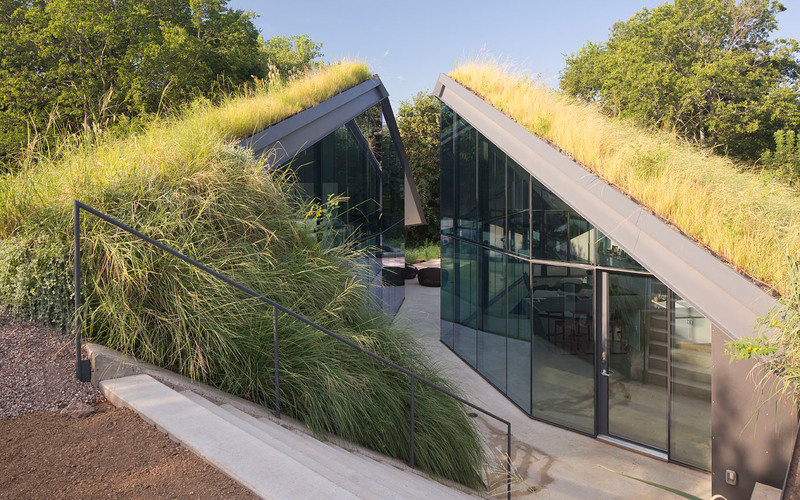Professional Practice
Increasing Energy Efficiency: Residential Green Roofs
 The roof and surrounding site contain 40 native species of plants and wildflowers. Edgeland House, Austin, Texas / Bercy Chen Studio LP
The roof and surrounding site contain 40 native species of plants and wildflowers. Edgeland House, Austin, Texas / Bercy Chen Studio LP Green roofs are energy-efficient vegetated roof systems. Once installed, they last longer than conventional roofs. While the energy saving benefits of commercial green roofs are already well known, residential green roofs can also dramatically improve home energy efficiency. Green roofs regulate buildings' internal temperature and reduce building heating and cooling costs.
Green roofs also function as sustainable, decentralized stormwater management systems by reducing run-off and decreasing the energy costs associated with extending and upgrading centralized systems.
Green roofs benefits include:
- Cost-efficiency: A University of Michigan study showed that more than 50 percent of the cost associated with installing a green roof will be returned in the form of lower maintenance and reduced energy usage over the lifetime of the green roof system. “Nearly two-thirds of these savings would come from reduced energy needs for the building with the green roof.”
- Energy savings: A typical 2-3 story building could experience 15-25 percent savings in summertime energy costs.
- Lower air temperatures: A modeling study found that adding green roofs to 50 percent of the available surfaces in downtown Toronto would cool the entire city by 0.2 to 1.4°F (0.1 to 0.8°C).
- More efficient stormwater management: Green roofs can reduce stormwater peak flow rates by up to 65 percent and increase the time it take the water to reach the sewer by 3 hours.
- Long lifespan than conventional roofs: Green roofs can extend a roof’s lifespan by two or three times. According to the General Services Administration, “Green roofs provide a payback… of approximately 6.2 years nationally…conservative analysis puts the average life expectancy of a green roof at 40 years, versus 17 for a conventional roof.”
- Lower long-term maintenance costs: According to Sustainable South Bronx, a non-profit organization, on a 90 degree day a green roof is about 80°F, while a black roof is 175°F. The higher temperatures cause substantial wear and tear.
- Reduces heat flux and provides insulation: Green roofs can limit the transfer of heat from a building exterior to its interior by up to 72 percent.
Sources: “Reducing Urban Heat Islands: Compendium of Strategies, Green Roofs,” U.S. Environmental Protection Agency, Sustainable South Bronx, and “The Benefits and Challenges of Green Roofs on Public and Commercial Buildings,” U.S. General Services Administration
Organizations
Centre for Architectural Ecology, British Columbia Institute of Technology
Center for Green Roof Research, Pennsylvania State University
Green Roofs for Healthy Cities
International Green Roof Association
Lady Bird Johnson Wildflower Center / Green Roof Resources
Living Roofs (United Kingdom)
Resources
Green Roofs Benefits, Green Roofs for Healthy Cities
Green Roof Research Program, Department of Horticulture, Michigan State University
Green Roofs Sequester CO2, The Dirt, American Society of Landscape Architects (ASLA)
Green Roof Tax Credits, ASLA Advocacy
Residential Buildings: Roofs, U.S. Department of Energy
Heat Island Mitigation Strategies, Environmental Protection Agency
The New Philadelphia Story is About Green Infrastructure, The Dirt, American Society of Landscape Architects (ASLA)
Living Architecture Monitor
Green roofs, University of Delaware Botanic Gardens
Ecoroof Video – The Nature of Portland’s Rooftops, City of Portland
Research
"Green Roof Plants: A Resource and Planting Guide," Edmund C. & Lucie L. Snodgrass, Timber Press, 2006
"Green Roof Systems: A Guide to the Planning, Design, and Construction of Building Over Structure," Susan Weiler & Katrin Scholz-Barth, Wiley, 2005
“Handbook of Biophilic City Planning and Design,” Timothy Beatley, Island Press, 2016
“Small Green Roofs: Low-Tech Options for Greener Living,” Nigel Dunnett, Dusty Gedge, John Little, Edmund C. Snodgrass, Timber Press, 2011
Government Resources
City of Toronto Green Roof Bylaw, Toronto, Canada
Illinois Energy Plan: Green Roof Program, State of Illinois
The London Plan: Living Roofs and Walls, City of London
Tax Credits for Green Roofs in NYC, Environmental Leader, June 29, 2008.
Riversmart Rooftops, Washington, D.C.
Credits for Green Roof Projects, Austin, Texas
2017 Green Infrastructure Partnership Program, Milwaukee, Wisconsin
Green roof rebate, Nashville, Tennessee
Portland Ecoroofs, Portland, Oregon
Green Roofs, Milwaukee Metropolitan Sewerage District
Projects
Edgeland House, Austin, Texas
Bercy Chen Studio
Feldman Residence, Santa Lucia Preserve, Carmel, California
Blasen Landscape Architecture
Macallen Building Condominiums, Boston, Massachusetts
Landworks Studio, Inc
Logan Square, Chicago, Illinois
Omni Ecosystems
38 Dolores, San Francisco, California
Designworks Inc.
Taylor Residence, Kennett Square, Pennsylvania
Land Ethics
Padaro Lane, Carpinteria, California
Keith LaBlanc Landscape Architecture
Lakeside Senior Apartments, Oakland, California
PGA Design
684 Broadway, New York, New York
Balmori Associates